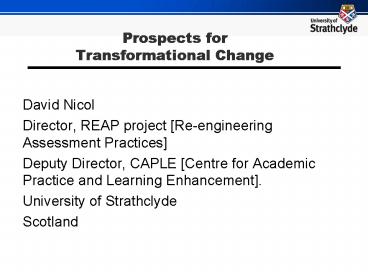Prospects for Transformational Change PowerPoint PPT Presentation
1 / 12
Title: Prospects for Transformational Change
1
Prospects for Transformational Change
- David Nicol
- Director, REAP project Re-engineering Assessment
Practices - Deputy Director, CAPLE Centre for Academic
Practice and Learning Enhancement. - University of Strathclyde
- Scotland
2
Introduction
- What do we mean by transformational change?
- Can ICT transform learning?
- How might we go about it?
3
What counts as transformation?
- SFC large scale/rapid pace of change
- Real changes but not perceived as
transformational - Appearance of transformation but not..
- Cumulative benefit but no step change
4
What counts as valuable?
- In higher education
- Learning quality gains
- Cost reductions
- Two examples regarded by many as transformational
Peer Instruction (Mazur) and Program in Course
Redesign (Twigg)
5
Peer Instruction Electronic Voting systems
- Eric Mazur (1997 Crouch and Mazur, 2001)
- Goal address conceptual misunderstandings in
physics. - Approach Peer Instruction (teaching through
questioning with voting and peer discussion) - Technology electronic voting systems
- Significant learning gains (Force Concept
Inventory) - Massive worldwide adoption of PI and EVS
- Hake (1998) tested 62 courses 6542 students
6
Twigg (1999-02) Pew Foundation Program in
Course Redesign (PCR)
- Goals reduce costs and improve learning quality
- Focus large 1st-year classes, multiple
disciplines - Bids rigorous procedure, highly selective and
supportive, 30 courses many institutional types. - Detailed ready to go implementation plan
- Outcomes cost saving (37 3.6m pa), improved
learning (standard tests) in 25 of 30 courses - 5 redesign models supplemental, replacement,
emporium, buffet and fully online
7
How can we promote transformation?
- Peer Instruction pedagogy the driver
- PCR (Twigg) two-step process - money to create
evidence then no money. - What should we spend money on?
- Can we spend teaching money on research?
8
Where to focus class, course, institution
- Can we transform teaching in isolation?
- PI class level
- PCR established favourable conditions
institutionally - REAP complexity of changing both levels
simultaneously.
9
Does collaboration support T-change?
- Most UK projects require cross-institutional
collaboration - PCR prohibited collaboration
- REAP benefits of collaboration (shared risks,
ideas, dissemination) but cross-institutional
collaboration is resource-intensive
10
Key lessons from Pew Program
- You can achieve measurable comparative benefits
- You can have it both ways (cost and quality)
- You only get what you aim for PCR process
involved advance support and targeted plans
11
Some supporting conditions for transformation
- Motivation to undertake change and redesign
- Pedagogical ideas about what kinds of change can
be powerful - Staff development - experience in redesign
- A culture of evidence-based teaching
- Dissemination different types (e.g. talking to
those who have redesigned)
12
Reference
- Paper to go with this presentation
- Transformation in e-Learning by Steve Draper
and David Nicol - Available at-
- http//www.psy.gla.ac.uk/steve/rap/docs/transf1.p
df

